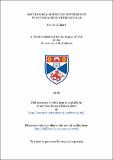Files in this item
Isothiourea-mediated synthesis of functionalised heterocycles
Item metadata
| dc.contributor.advisor | Smith, Andrew David | |
| dc.contributor.author | Stark, Daniel G. | |
| dc.coverage.spatial | 292 p. | en_US |
| dc.date.accessioned | 2019-02-06T16:03:50Z | |
| dc.date.available | 2019-02-06T16:03:50Z | |
| dc.date.issued | 2016-09-26 | |
| dc.identifier.uri | https://hdl.handle.net/10023/17008 | |
| dc.description.abstract | The research outlined in this thesis describes methodologies for the synthesis of functionalised heterocycles through the use of C1-ammonium enolate catalysis utilising isothiourea organocatalysts. Chapter 2: Initial work demonstrated a DHPB-mediated Michael addition-lactamisation/PhSH elimination/N- to O-sulfonyl transfer one-pot cascade for the synthesis of 2,4,6-substituted pyridine sulfonates. Applying (phenylthio)acetic acid and a range of a,ß-unsaturated ketimines, pyridine sulfonates were obtained in moderate to good yield (40-69%) with the functionalisation of the incorporated sulfonate group examined through various derivatisations. Chapter 3: The established isothiourea-mediated pyridine methodology was expanded into the synthesis of 2,3- and 2,3,5-substituted pyridine 6-tosylates through a three-stage Michael addition-lactamisation, S-oxidation-sulfoxide elimination and N- to O-sulfonyl transfer protocol. Using (phenylthio)acetic acids and 2-N-tosyliminoacrylates a range of pyridine products were provided in moderate to good yield over the three-stage process (44-72%). Derivatisation of the installed sulfonate group allowed access into 2,3-, 2,3,5-, 2,3,6 and 2,3,5,6-substituted pyridines. Chapter 4: Subsequent studies expanded the scope of dihydropyranone and dihydropyridinone products accessible through isothiourea-catalysis using 2-aroyl acrylates or 2-N-tosyliminoacrylates in an enantioselective Michael addition-cyclisation process. It was discovered that the use of homoanhydride enolate precursors was necessary when applying 2-aroyl acrylates to ensure high enantioselectivity (up to 99%) and reproducibility of the dihydropyranone products, while carboxylic acids can be used with 2-N-tosyliminoacrylates, providing dihydropyridinones in high enantioselectivity (typically >90% ee). Chapter 5: Enantioselective Michael addition-lactonisation of 2-aryl and 2-alkenylacetic acids and a,ß-unsaturated trichloromethyl ketones, catalysed by (2S,3R)-HyperBTM was shown to give dihydropyranones with subsequent ring opening and substitution of the CCl₃ group providing a range of diesters and diamides in high diastereo- and enantioselectivity (up to 95:5 and up to >99% ee). Chapter 6: The pyrrolizine core is present in many biologically relevant molecules. It was demonstrated that an isothiourea-catalysed enantioselective Michael addition-lactonisation/ring opening process gives access to these important molecules with exquisite diastereo- and enantioselectivity (typically >95:5 dr and >99% ee). A novel synthetic route into the synthesis of the pyrrole enone-acid substrates was established, hence making the overall methodology more efficient and reproducible. Computational studies are provided to compliment the synthetic studies with investigations into the origin of the high stereocontrol observed in this process. Chapter 7: Saccharin-derived Michael acceptors have been shown as useful substrates in isothiourea-catalysis. (2R,3S)-HyperBTM catalyses the Michael addition-lactamisation of carboxylic acids and saccharin-derived Michael acceptors to give 8,9-dihydro-7H benzo[4,5]isothiazolo[2,3-a]pyridin-7-one 5,5-dioxides in good to excellent stereocontrol (80:20->95:5 dr and 71->99% ee). Furthermore, these Michael acceptors can be utilised with 1-(1H-imidazol-1-yl)-2-(phenylthio)ethan-1-one in a Michael addition-lactamisation/PhSH elimination process giving access to the corresponding 1,2-benzoisothiazolopyridone 1,1-dioxide heterocycle in a chromatography-free procedure. | en |
| dc.language.iso | en | en_US |
| dc.publisher | University of St Andrews | |
| dc.subject.lcc | QD400.5S95S8 | |
| dc.subject.lcsh | Heterocyclic compounds--Synthesis | en |
| dc.subject.lcsh | Thiourea | en |
| dc.title | Isothiourea-mediated synthesis of functionalised heterocycles | en_US |
| dc.type | Thesis | en_US |
| dc.type.qualificationlevel | Doctoral | en_US |
| dc.type.qualificationname | PhD Doctor of Philosophy | en_US |
| dc.publisher.institution | The University of St Andrews | en_US |
This item appears in the following Collection(s)
Items in the St Andrews Research Repository are protected by copyright, with all rights reserved, unless otherwise indicated.

